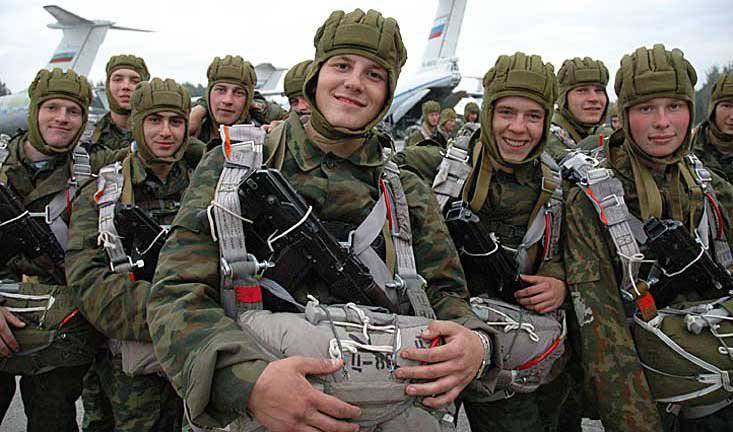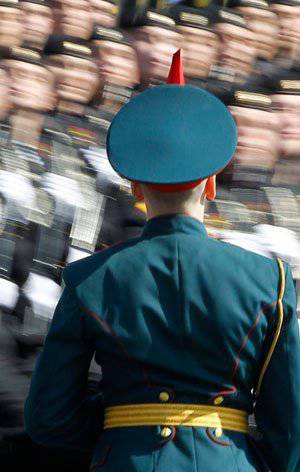Justification of the Armed Forces of Russia
The army inherited from the Soviet Union (2,8 million people in 1992) proved an unbearable burden for the Russian state, primarily because of the lack of sufficient financial resources. The result of several reforms of the Armed Forces, including bringing to a new look, was a reduction in their numbers to one million.
According to a number of experts, such a number of personnel of the Armed Forces of the Russian Federation can be considered as a compromise between the required and possible number. However, there remains an open question about a reasonable numerical strength sufficient to deter, repel any possible aggression and solve other tasks assigned to the Russian army.
On the question of what should be the size of the Armed Forces of the Russian Federation, there are disputes in society.
The liberal part of the political and scientific elite proves that it is enough to have 600 – 800 thousands of people. These figures are justified by references to other countries of the world, primarily Europe, as well as by the limited material capabilities of the state in maintaining a larger army.
Today, when the military budget has reached a decent size - about 23 trillion rubles for ten years, the arguments for the lack of financial resources cannot be considered a weighty reason to justify these figures. The arguments of relatively small armies of European countries are also incorrect: the conditions for ensuring military security are too different. Only in terms of the territory of Russia is more than all these states combined.

What is necessary to make a start when determining the size of the Russian Armed Forces? The answer is obvious: if they are designed to counter military threats, then their size should be sufficient to perform this task in the most difficult conditions.
That is, the army is obliged to ensure the security of Russia in all wars and armed conflicts that may be unleashed against our Motherland or in which it may be drawn in due to the negative development of the international situation.
Threat assessment
Analysis of the current economic and military-political situation, its development trends shows that a number of military threats are relevant to Russia to some extent, to neutralize or prevent which national armed forces can be used.
Border conflicts are potentially possible in the west (in relations with the Baltic countries) - due to territorial disputes, north-west (with Norway) - due to the division of exclusive economic zones in the Barents and Norwegian Seas, to the south - due to possible expansion by the Islamic fundamentalists (in particular the Taliban). In all these areas, the likelihood of such conflict situations is currently estimated as low, but it can increase in the future. There is also the danger of a worsening of relations between Russia and Georgia, of drawing in groups of Russian troops in the Georgian-Abkhaz and Georgian-South Ossetian conflicts. The likelihood of such a scenario is average.
 Armed conflicts can be the result of an escalation of border or attempts to resolve territorial disputes by military means. The average probability of such conflicts arises in the North Caucasus region in connection with the claims of Georgia to restore territorial integrity. There is, however, an exceptionally low risk of provoking an armed conflict between Russia and Japan over the Kuril Islands. The current instability of the situation in the Central Asian region supports the slight danger of the outbreak of hostilities in the Russian south.
Armed conflicts can be the result of an escalation of border or attempts to resolve territorial disputes by military means. The average probability of such conflicts arises in the North Caucasus region in connection with the claims of Georgia to restore territorial integrity. There is, however, an exceptionally low risk of provoking an armed conflict between Russia and Japan over the Kuril Islands. The current instability of the situation in the Central Asian region supports the slight danger of the outbreak of hostilities in the Russian south.Due to the growing socio-political tensions in Russia, the deepening global crisis and the intensification of US intelligence services to detach the Caspian region from our country by destabilizing the situation in the republics of the North Caucasus, the likelihood of internal armed conflicts in the region increases (estimated as high), also in depressed regions of Russia (medium).
A local war may arise in the North Caucasus region as a result of the escalation of armed conflicts in the republics of the North Caucasus and on the borders of Georgia with Abkhazia and South Ossetia, with Russia being drawn in, with the possibility of their internationalization due to the intervention of (directly or hidden) individual NATO countries.
In addition, with the withdrawal of the troops of the North Atlantic Alliance from Afghanistan, there is a growing likelihood of a number of internal or interstate conflicts in the Central Asian republics, which, as a result of aggravation, can turn into a local war.
The emergence of a regional war against the Russian Federation is possible only against the background of the development of large-scale military operations. Moreover, if Russia enters the coalition of states opposing the countries of Western civilization, it will flow in the western direction, and if the Russian side is in alliance with the West, then we should expect its development in the East, where China will be the main opponent.
The possibility of the start of world war today is continuously growing due to the deepening global crisis, which can be resolved only by changing the entire system of the world structure. Such processes in the twentieth century have already caused two large-scale wars, and it is extremely difficult to assume that this, even deeper crisis will be resolved bloodlessly. Today, it is still possible to assess the possibility of a world war as low, but in the future it will begin to grow and Russia will almost certainly be drawn into it.
Scale of conflict
Thus, the Armed Forces of Russia must be ready to ensure the country's military security in wars and armed conflicts of the following types:
1. Border conflict is limited to a separate operational-important area, and its duration is from several days to one or two months. To resolve it, each of the parties will have to involve a group of troops (forces) numbering from two to three to five to ten thousand people. The period of immediate preparation can be from one to five days. Often, such a conflict situation serves as a pretext for unleashing a larger military action.
2. An armed conflict can take one operational direction, and last from several days or months to several years. Each side will be forced to attract a grouping of troops (forces) numbering from 30 – 40 to 100 – 120 thousand people. For immediate preparation it will take up to several weeks. Participants in the confrontation set themselves, as a rule, limited political goals.
Internal armed conflicts that represent the most acute form of domestic political confrontation are distinguished as a separate type.
3. A local war can take place in one strategic direction, and in duration from a few months to several years. The groupings of troops (forces) of each of the parties should be from 500 thousand to one million people or more. The period of direct preparation for such a war is several months. The parties have set themselves, as a rule, fairly ambitious political goals, such as, for example, the implementation of large territorial claims, up to and including annexation.
4. Regional war on space covers several strategic areas and lasts for several years. For its conduct, each of the parties will have to involve a grouping of troops (forces) numbering from four to five to ten million people. Direct training usually ranges from one to several years. Within its framework, extremely decisive political goals are achieved, such as, for example, annexing entire countries, changing the political system or power elite in large countries, and establishing military-political control over important regions of the world.
5. World War will cover all major regions of the Earth, the duration - from several years to several decades. It will certainly be a coalition with the participation of the opposing alliances of all leading countries. Each of the parties involved uses all available military, economic and spiritual potential. Structurally, the war will represent a system of regional and local wars in various theaters of military operations. The total composition of the opposing groups of troops (forces) can reach several tens of millions of people. The period of direct preparation will be several years. Entry into a world war will occur in the form of an escalation of several armed conflicts and local wars in regional war that initially form in the aggregate. In a large-scale war, geopolitical goals of global importance are being solved, first of all it can be the construction of a new world order.
Required composition
The analysis made allows us to conclude that the Russian Armed Forces should be capable in peacetime:
With full or partial mobilization deployment:
to force the enemy to abandon further military aggression in a regional war, with its direct occurrence through the use of all kinds
Strategic nuclear forces carry out guaranteed containment of the threat of use of weapons of mass destruction by other countries possessing such weapons.
Based on the above requirements, with full mobilization deployment within the domestic Armed Forces, there should be from 2,5 to 3,5 a million people, including from 0,6 to 1,5 million in the groupings solving tasks in one or two local wars in one or two strategic areas, the rest - forces covering the border in other areas, systems of comprehensive support and management.
Based on the required military time in 3,5 million and the average rate of mobilization deployment in 2,3 – 2,7 (according to the experience of the Second World War, conflicts of the second half of the XX - beginning of the XXI century), we can determine the minimum required composition of the Armed Forces of the Russian Federation of Peacetime - 1,2 – 1,5 a million people.
Information